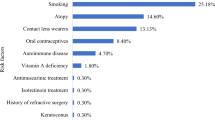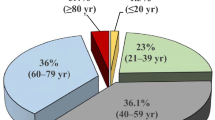Abstract
Purpose
To investigate the prevalence of ocular Demodex folliculorum (DF) in an Irish population. To validate a modified Ocular Surface Disease Index questionnaire and employ it to evaluate the relationship between dry eye symptoms and the presence of DF.
Methods
One hundred and fifty-six subjects were enrolled in an epidemiological cross-sectional prevalence study. Each subject completed a novel questionnaire on ocular symptoms and was assessed for the presence of DF. Data was analysed to assess prevalence and to search for significant links between each symptom and DF.
Results
An overall prevalence of 68% was found. Total mean number of DF found on microscopic examination was 3.83 mites per subject (range 0–25). The presence of symptoms was higher among individuals with DF (P = 0.04). Itch was found to be the symptom most significantly associated with the presence and number of DF (P = 0.025 and P = 0.035, respectively). The questionnaire showed good internal consistency (Cronbach’s alpha; α > 0.7) and good reliability (Intra-class Correlation Co-efficient; ICC > 0.7). The sensitivity and specificity of a positive symptom result using the questionnaire were 70.8% and 46.9%, respectively.
Conclusion
There is a strong association between the prevalence of DF and symptoms, in particular itchy eyes. However, not all patients with DF will be symptomatic. The newly developed questionnaire is a reliable instrument for measuring change in symptoms over a period of time and suitable for observing patient reported outcomes in interventional treatment studies.



Similar content being viewed by others
References
Spickett SG (1961) Studies on Demodex folliculorum Simon (1842). I. Life history. Parasitology 51:181–192
Rufli T, Mumcuoglu Y (1981) The hair follicle mites Demodex folliculorum and Demodex brevis: biology and medical importance. Dermatologica 162:1–11
English FP, Nutting WB (1981) Demodicosis of ophthalmic concern. Am J Ophthalmol 91:362–372
Aylesworth R, Vance JC (1982) Demodex folliculorum and Demodex brevis in cutaneous biopsies. J Am Acad Dermatol 7:583–589. https://doi.org/10.1016/S0190-9622(82)70137-9
Lacey N, Kavanagh K, Tseng S (2009) Under the lash: Demodex mites in human diseases. Biochem (Lond) 31:2–6
Coston T (1967) Demodex folliculorum blepharitis. Trans Am Ophthalmol Soc 65:361–392
Liu J, Sheha H, Tseng SCG (2010) Pathogenic role of Demodex mites in blepharitis. Curr Opin Allergy Clin Immunol 10:505–510
Schear MJ, Milman T, Steiner T et al (2015) The association of Demodex with chalazia: a histopathologic study of the eyelid. Ophthalmic Plast Reconstr Surg 32:275–278. https://doi.org/10.1097/IOP.0000000000000500
English F (1971) Demodex folliculorum and oedema of the eyelash. Br J Ophthal 55:742–746
Nicholls SG, Oakley CL, Tan A, Vote BJ (2017) Demodex species in human ocular disease: new clinicopathological aspects. Int Ophthalmol 37:303–312. https://doi.org/10.1007/s10792-016-0249-9
Gao YY, Di Pascuale MA, Li W et al (2005) High prevalence of Demodex in eyelashes with cylindrical dandruff. Investig Ophthalmol Vis Sci 46:3089–3094
Solomon A, Dursun D, Liu Z et al (2001) Pro- and anti-inflammatory forms of interleukin-1 in the tear fluid and conjunctiva of patients with dry-eye disease. Invest Ophthalmol Vis Sci 42:2283–2292
De Paiva C, Pflugfelder S (2008) Rationale for anti-inflammatory therapy in dry eye syndrome. Arq Bras Oftalmol 71:89–95
Savini G, Prabhawasat P, Kojima T et al (2008) The challenge of dry eye diagnosis. Clin Ophthalmol 2:31–55
Koo H, Kim TH, Kim KW et al (2012) Ocular surface discomfort and Demodex: effect of tea tree oil eyelid scrub in Demodex blepharitis. J Korean Med Sci 27:1574–1579
Sullivan BD, Crews L, Messmer EM et al (2014) Correlations between commonly used objective signs and symptoms for the diagnosis of dry eye disease: clinical implications. Acta Ophthalmol 92:161–166
Nichols K, Nichols J, Mitchell G (2004) The lack of association between signs and symptoms in patients with dry eye disease. Cornea 23:762–770
Sullivan BDBD, Whitmer D, Nichols KKK et al (2010) An objective approach to dry eye disease severity. Investig Ophthalmol Vis Sci 51:6125–6130. https://doi.org/10.1167/iovs.10-5390
Pult H, Purslow C, Murphy PJ (2011) The relationship between clinical signs and dry eye symptoms. Eye (Lond) 25:502–510. https://doi.org/10.1038/eye.2010.228
Achtsidis V, Kozanidou E, Bournas P et al (2014) Dry eye and clinical disease of tear film, diagnosis and management. Eur Ophthalmic Rev 8:17–22. https://doi.org/10.17925/EOR.2014.08.01.17
Kim JT, Lee H, Chun YS, Kim JC (2011) Tear cytokines and chemokines in patients with Demodex blepharitis. Cytokine 53:94–99
Kabataş N, Doğan AŞ, Kabataş EU et al (2017) The effect of Demodex infestation on blepharitis and the ocular symptoms. Eye Contact Lens 43:64–67
Sędzikowska A, Osęka M, Grytner-Zięcina B (2016) Ocular symptoms reported by patients infested with Demodex mites. Acta Parasitol 61:808–814
Jarmuda S, O’Reilly N, Zaba R et al (2012) Potential role of Demodex mites and bacteria in the induction of rosacea. J Med Microbiol 61:1504–1510
Sahai Malik P, Sahai A, Malik P (2005) Dry eye: prevalence and attributable risk factors in a hospital-based population. Indian J Ophthalmol 53:87–91. https://doi.org/10.4103/0301-4738.16170
Pesudovs K, Burr JM, Harley C, Elliott DB (2007) The development, assessment, and selection of questionnaires. Optom Vis Sci 84:663–674
Willke RJ (2008) Measuring the value of treatment to patients: patient-reported outcomes in drug development. Am Heal Drug Benefits 1:34–40
Schaumberg DA, Nichols JJ, Papas EB et al (2011) The international workshop on meibomian gland dysfunction: report of the subcommittee on the epidemiology of, and associated risk factors for, MGD. Investig Ophthalmol Vis Sci 52:1994–2005
World Medical Association (2013) World Medical Association declaration of Helsinki ethical principles for medical research involving human subjects. JAMA 310:2191–2194
Gao YY, Di Pascuale MA, Li W et al (2005) In vitro and in vivo killing of ocular Demodex by tea tree oil. Br J Ophthalmol 89:1468–1473. https://doi.org/10.1136/bjo.2005.072363
Mastrota KM (2013) Method to identify Demodex in the eyelash follicle without epilation. Optom Vis Sci 90:e172–e174. https://doi.org/10.1097/OPX.0b013e318294c2c0
Wolffsohn JS, Arita R, Chalmers R et al (2017) TFOS DEWS II diagnostic methodology report. Ocul Surf 15:539–574. https://doi.org/10.1016/j.jtos.2017.05.001
Tomlinson A, Bron AJ, Korb DR et al (2011) The international workshop on meibomian gland dysfunction: report of the diagnosis subcommittee. Investig Ophthalmol Vis Sci 52:2006–2049
Schiffman RM, Christianson MD, Jacobsen G et al (2000) Reliability and validity of the ocular surface disease index. Arch Ophthalmol 118:615. https://doi.org/10.1001/archopht.118.5.615
Jalbert I, Rejab S (2015) Increased numbers of demodex in contact lens wearers. Optom Vis Sci 92:671–678
Lee SH, Chun YS, Kim JH et al (2010) The relationship between demodex and ocular discomfort. Investig Ophthalmol Vis Sci 51:2906–2911
Walt J (2004) Ocular surface disease index (OSDI) administration and scoring manual
Mathews PM, Ramulu PY, Friedman DS et al (2013) Evaluation of ocular surface disease in patients with glaucoma. Ophthalmology 120:2241–2248. https://doi.org/10.1016/j.ophtha.2013.03.045
Miller KL, Walt JG, Mink DR et al (2010) Minimal clinically important difference for the ocular surface disease index. Arch Ophthalmol 128:94–101. https://doi.org/10.1001/archophthalmol.2009.356 (Chicago, Ill 1960)
Smith JA, Albenz J, Begley C et al (2007) The epidemiology of dry eye disease: report of the epidemiology subcommittee of the international dry eye workshop (2007). Ocul Surf 5:93–107
Bland JM, Altman DG (1997) Statistics notes: Cronbach’s alpha. BMJ. https://doi.org/10.1136/bmj.314.7080.572
Tavakol M, Dennick R (2011) Making sense of Cronbach’s alpha. Int J Med Educ 2:53–55
Hallgren KA (2012) Computing inter-rater reliability for observational data: an overview and tutorial. Tutor Quant Methods Psychol 8:23–34
Rosner B (2011) Fundamentals of biostatistics, 7th edn. Brooks/Cole, Boston
Costello AB, Osborne JW, Costello AB (2009) Best practices in exploratory factor analysis: four recommendations for getting the most from your analysis. Pan Pacific Manag Rev 12:131–146
Roth AM (1979) Demodex folliculorum in hair follicles of eyelid skin. Ann Ophthalmol 11:37–40
Forton F, Seys B (1993) Density of Demodex folliculorum in rosacea: a case-control study using standardized skin-surface biopsy. Br J Dermatol 128:650–659
Randon M, Liang H, El Hamdaoui M et al (2015) In vivo confocal microscopy as a novel and reliable tool for the diagnosis of Demodex eyelid infestation. Br J Ophthalmol 99:336–341. https://doi.org/10.1136/bjophthalmol-2014-305671
Kemal M, Sümer Z, Toker MI et al (2005) The prevalence of Demodex folliculorum in blepharitis patients and the normal population. Ophthalmic Epidemiol 12:287–290
Baima B, Sticherling M (2002) Demodicidosis revisited. Acta Derm Venereol 82:3–6
Elston DM (2010) Demodex mites: facts and controversies. Clin Dermatol 28:502–504
Lacey N, Ní Raghallaigh S, Powell FC (2011) Demodex mites–commensals, parasites or mutualistic organisms? Dermatology 222:128–130
de Venecia AB, Lim Bon Siong R (2011) Demodex sp. infestation in anterior blepharitis, meibomian-gland dysfunction, and mixed blepharitis. Philipp J Ophthalmol 36:15–22
Bhandari V, Reddy JK (2014) Blepharitis: always remember demodex. Middle East Afr J Ophthalmol 21:317–320
Forton F, Germaux M-A, Brasseur T et al (2005) Demodicosis and rosacea: epidemiology and significance in daily dermatologic practice. J Am Acad Dermatol 52:74–87
Villani E, Magnani F, Viola F et al (2013) In vivo confocal evaluation of the ocular surface morpho-functional unit in dry eye. Optom Vis Sci 90:576–586
Hoşal BM, Örnek N, Zilelioğlu G, Elhan AH (2005) Morphology of corneal nerves and corneal sensation in dry eye: a preliminary study. Eye 19:1276–1279
Bourcier T, Acosta MC, Borderie V et al (2005) Decreased corneal sensitivity in patients with dry eye. Investig Ophthalmol Vis Sci 46:2341
Lemp MA, Baudouin C, Baum J et al (2007) The definition and classification of dry eye disease: report of the definition and classification subcommittee of the international dry eye work shop (2007). Ocul Surf 55:75–92
Gao YY, Di Pascuale MA, Elizondo A, Tseng SC (2007) Clinical treatment of ocular demodicosis by lid scrub with tea tree oil. Cornea 26:136–143
Kheirkhah A, Casas V, Li W et al (2007) Corneal manifestations of ocular Demodex infestation. Am J Ophthalmol 143:743–749
Kojima T, Ishida R, Sato EA et al (2011) In vivo evaluation of ocular demodicosis using laser scanning confocal microscopy. Investig Ophthalmol Vis Sci 52:565–569
Georgala S, Katoulis AC, Kylafis GD et al (2001) Increased density of Demodex folliculorum and evidence of delayed hypersensitivity reaction in subjects with papulopustular rosacea. J Eur Acad Dermatol Venereol 15:441–444
Acknowledgements
The authors’ thanks the management and staff of the National Optometry Centre for providing use of the premises and equipment, and helping with diary management and subject recruitment. The final year Optometry students assisted with data collection and subject recruitment.
Author information
Authors and Affiliations
Corresponding author
Ethics declarations
Conflict of interest
The authors declare that they have no conflict of interest. This research was conducted as part of a self-funded postgraduate research degree.
Human and animal rights
All procedures performed in this study involving human participants were in accordance with the ethical standards of Dublin Institute of Technology and with the Tenets of Helsinki Declaration of Human Studies [29].
Informed consent
Informed consent was obtained from all individual participants included in the study.
Electronic supplementary material
Below is the link to the electronic supplementary material.
Rights and permissions
About this article
Cite this article
Murphy, O., O’Dwyer, V. & Lloyd-McKernan, A. Ocular Demodex folliculorum: prevalence and associated symptoms in an Irish population. Int Ophthalmol 39, 405–417 (2019). https://doi.org/10.1007/s10792-018-0826-1
Received:
Accepted:
Published:
Issue Date:
DOI: https://doi.org/10.1007/s10792-018-0826-1




